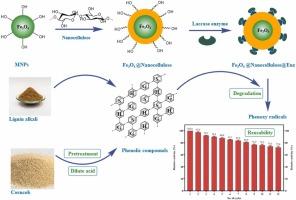利用漆酶固定在磁性可回收的纳米纤维素功能化氧化铁纳米颗粒上,高效、经济地降解木质纤维素生物质中的酚类化合物
IF 6.2
1区 农林科学
Q1 AGRICULTURAL ENGINEERING
引用次数: 0
摘要
漆酶被认为是一种高效的催化剂,在木质素降解和木质纤维素生物质可持续能源生产中有着广泛的应用。本研究提出了一种新的降解木质纤维素生物质结构中酚类化合物的方法,即将漆酶固定在纳米纤维素功能化的磁性纳米颗粒表面(Fe3O4@NC@Enz)。通过各种表征技术证实了该纳米生物催化剂的合成。在最佳固定化条件下,培养时间为8 小时,酶浓度为2 mg/mL,固定化率为93.26 %,相对活性为90.32 %。固定化后的漆酶在60天内的贮藏稳定性为其初始活性的68.9% %,在不同的pH和温度条件下均表现出优于游离酶的稳定性。本研究研究了Fe3O4@NC@Enz在降解酚类化合物中的应用,在12次重复使用后,降解率达到了木质素结构中总多酚含量的84.74 %,并且保持了72.4 %的催化活性。固定化漆酶对玉米芯的脱木质素和脱毒均有较好的效果,孵育12 小时后,脱毒率分别达到72 %和86.69 %。总之,研究结果强调了Fe3O4@NC@Enz在提高酶稳定性、活性和可重复使用性方面的有效性,为木质纤维素生物质的高效脱木质素和解毒提供了一种有前途的方法。本文章由计算机程序翻译,如有差异,请以英文原文为准。

Efficient and cost-effective biodegradation of phenolic compounds in lignocellulosic biomasses using laccase immobilized onto magnetically recoverable nanocellulose-functionalized iron-oxide nanoparticles
The laccase enzyme is considered as a highly effective catalyst with extensive applications in lignin degradation and sustainable energy production from lignocellulosic biomass. This study presents a novel approach for the degradation of phenolic compounds found in the structure of lignocellulosic biomasses by using laccase immobilized on the surface of nanocellulose-functionalized magnetic nanoparticles (Fe3O4@NC@Enz). The synthesis of this nanobiocatalyst was confirmed through various characterization techniques. Under optimal immobilization conditions, incubation time of 8 hours and enzyme concentration of 2 mg/mL, an impressive immobilization yield of 93.26 % and a relative activity of 90.32 % were achieved. The immobilized laccase demonstrated a storage stability of 68.9 % of its initial activity over a 60-day storage period and exhibited superior stability to that of the free enzyme under various pH and temperature conditions. This study investigated the application of Fe3O4@NC@Enz for degrading phenolic compounds, achieving a notable degradation rate of 84.74 % of the total polyphenol content in the lignin structure while retaining 72.4 % of its catalytic activity after 12 reuse cycles. The immobilized laccase was also effective in both delignification and detoxification of corncob, reaching rates of 72 % and 86.69 %, respectively, after 12 hours of incubation. In conclusion, the findings underscore the effectiveness of the Fe3O4@NC@Enz to improve enzyme stability, activity, and reusability, offering a promising approach for the efficient delignification and detoxification of lignocellulosic biomasses.
求助全文
通过发布文献求助,成功后即可免费获取论文全文。
去求助
来源期刊

Industrial Crops and Products
农林科学-农业工程
CiteScore
9.50
自引率
8.50%
发文量
1518
审稿时长
43 days
期刊介绍:
Industrial Crops and Products is an International Journal publishing academic and industrial research on industrial (defined as non-food/non-feed) crops and products. Papers concern both crop-oriented and bio-based materials from crops-oriented research, and should be of interest to an international audience, hypothesis driven, and where comparisons are made statistics performed.
 求助内容:
求助内容: 应助结果提醒方式:
应助结果提醒方式:


